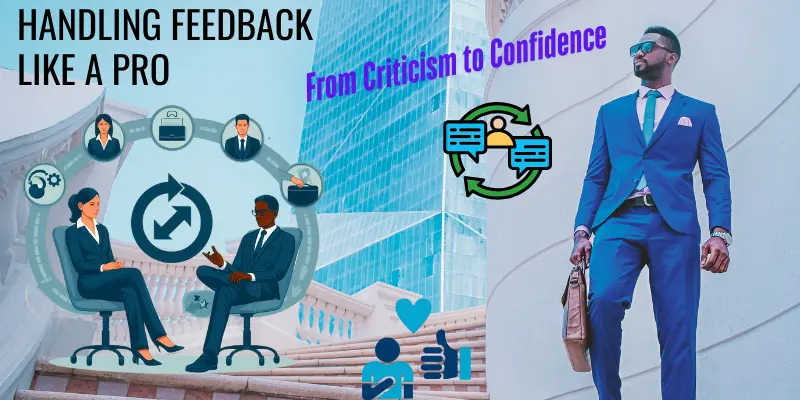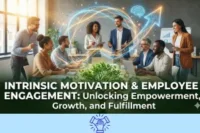How to Use Feedback to Fuel Your Professional Growth
Published: 28/03/2025
You’ve just finished a major project, feeling proud of your work. But when your manager gives feedback, it starts with praise, then a “but…” and suddenly, that confidence slips away. Sound familiar?
Research shows that 65% of people feel stressed about receiving feedback, especially when it’s critical (Gallup, 2017). It’s a tough pill to swallow, but here’s the thing: feedback, even when it’s tough, is one of the most powerful tools for growth. The challenge isn’t getting feedback—it’s knowing how to use it to improve.
In this post, I’ll show you how to turn feedback into actionable steps for your professional growth. You’ll learn how to process it, apply it, and build confidence along the way. Ready to make feedback work for you? Let’s dive in!
Feedback 101: What It Is and Why It’s Your Secret Weapon for Growth
Feedback isn’t just a review or an evaluation—it’s a tool that, when used properly, can help you unlock your true potential. It offers insights that you wouldn’t necessarily see on your own, helping you grow in ways you might not have imagined. When you embrace feedback, you open the door to continuous personal and professional growth.
Here’s how feedback unlocks your true potential:
Reveals Hidden Strengths: Often, we underestimate our strengths or take them for granted. Feedback can help you see these strengths more clearly, allowing you to build upon them and use them to your advantage.
Improves Weaknesses: Feedback helps identify areas where improvement is needed. By acknowledging and working on these areas, you can turn weaknesses into strengths, significantly enhancing your overall skills and capabilities.
Increases Self-Awareness: When you actively seek feedback, you gain a deeper understanding of how others perceive you and your work. This self-awareness is essential for making intentional, impactful changes that enhance your personal and professional growth.
Pushes You Outside Your Comfort Zone: Constructive feedback can challenge you to step outside your comfort zone. It encourages you to take on new challenges, try different approaches, and expand your skill set.
Fosters a Growth Mindset: Feedback fosters a mindset that sees challenges as opportunities rather than obstacles. It encourages you to continuously improve and evolve, pushing you to reach your full potential.
Feedback is the key to unlocking the next level of growth. It’s not just about hearing what you’re doing well—it’s about understanding where you can push yourself further, which ultimately helps you tap into the true potential you might not have known was there.
Types of Feedback
Feedback comes in many shapes and sizes, and each type serves a unique purpose:
- Positive Feedback: This is the feel-good kind. It’s when someone acknowledges what you’re doing well and praises your efforts.
Example: “Great job on that presentation! Your points were clear and well-structured.” - Constructive Feedback: This one can be tough to hear, but it’s incredibly helpful. It points out areas where you can improve and often includes suggestions for how to do so.
Example: “Your presentation was good, but try slowing down to make your points more impactful.” - Formal Feedback: This is the structured kind, usually given during performance reviews. It’s detailed and focuses on specific skills or outcomes.
Example: “In your review, we’ll look at your project management skills and how you can improve efficiency.” - Informal Feedback: This is more casual and often comes in the form of quick comments from peers or managers. It’s less structured but just as valuable for day-to-day improvements.
Example: “I think you handled that client call really well—just a suggestion to follow up with an email summary next time.”
Feedback is the breakfast of champions. If you want to grow faster than your peers, learn to crave constructive criticism like oxygenKen Blanchard, Leadership Expert & Co-author of The One Minute Manager
How to Think About Feedback
Here’s a mindset shift that can make all the difference: feedback isn’t about criticizing you as a person. It’s about helping you grow. Whether it’s positive or constructive, feedback is a roadmap to becoming the best version of yourself professionally.
So, the next time you receive feedback, don’t just listen—really hear it. Ask yourself: What can I learn from this? How can I use it to get better? Because at the end of the day, feedback isn’t just about where you are now—it’s about where you’re headed.
“Next up, we’ll dive into how to handle feedback like a pro—so you can turn even the toughest comments into opportunities for growth.”
How to Handle Feedback Like a Pro: Turning Criticism into Confidence
Receiving feedback, especially if it’s constructive or critical, can be challenging. But learning to handle it gracefully is key to growing from it and improving your performance.

Here’s how you can make the process easier and more productive:
Active Listening:
Listening is the first step in receiving feedback effectively. Instead of focusing on what you want to say in response, take time to fully understand the feedback being given.
Focus on Understanding:
When receiving feedback, try to listen without interrupting. Focus on the person’s words and intentions, rather than forming your own response.
Tip: If something isn’t clear, ask clarifying questions.
For example, “Could you clarify what you mean by that?” This helps ensure you understand their perspective fully.
Avoid Defensiveness:
It’s normal to feel defensive, but try to resist the urge to justify yourself. Instead, listen to the feedback without taking it personally.
Example: If your boss mentions your presentation could be clearer, resist explaining why it wasn’t clear—just listen and reflect on how to improve.
The moment you feel defensive is the moment you’ve stopped learning. Lean into discomfort—that’s where growth happensBrené Brown, Researcher & Author of Dare to Lead
Managing Emotions:
Feedback can stir up emotions—whether it’s frustration, embarrassment, or self-doubt. However, managing these emotions helps you stay open to growth.
Stay Calm and Open-Minded:
It’s easy to feel upset or embarrassed by criticism, but it’s essential to stay composed.
Breathe, listen, and process the information without letting emotions cloud your judgment. Tip: Take a moment if you need to. Responding right away can lead to reactions you might regret later.
Shift Your Mindset:
Remind yourself that feedback is not an attack on you as a person but rather a tool to improve your skills.
Every professional receives feedback, even the most successful ones. Example: When someone points out an error in your report, see it as an opportunity to do better next time rather than a blow to your self-esteem.
Expressing Gratitude:
Even if the feedback is tough to hear, expressing gratitude helps you stay professional and shows maturity. It’s an important step in turning the feedback into a learning experience.
Thank the Person Giving Feedback:
Acknowledge their time and effort in helping you grow. A simple “Thank you for your feedback” can go a long way.
Example: After receiving feedback, say, “I appreciate you taking the time to help me improve. I’ll work on that area.”
Show Appreciation for Constructive Criticism:
If feedback is critical but helpful, thank them for being honest.
The more you appreciate the value in feedback, the easier it becomes to grow from it.
Tip: Remember, most people giving you feedback genuinely want you to succeed. Recognizing their effort helps strengthen relationships and shows that you’re receptive.
Reflect on the Feedback:
Taking time to process feedback is essential for making the most of it. Instead of brushing it off, reflect on it deeply.
- Take Time to Think: Once you’ve received feedback, give yourself time to reflect. Think about how you can apply what you’ve learned to improve your performance.
Tip: Journal about the feedback, or take notes on specific actions you can take. This helps clarify your next steps.
- Recognize Patterns: Look for recurring feedback themes. If you consistently hear the same suggestion, it’s a sign that it’s something worth addressing in your growth journey.
By actively listening, managing emotions, expressing gratitude, and reflecting on feedback, you’ll be in a much stronger position to use it for personal and professional growth.
In the next section, we’ll dive into how to act on feedback and turn it into meaningful change in your career. Stay tuned!
From Feedback to Action: How to Turn Insights into Real Results
Receiving feedback is just the first step. To truly grow, you need to take action on what you’ve learned. Here’s how to turn feedback into meaningful change:
Analyzing Feedback:
Once you’ve received feedback, it’s time to dive into the details and understand it fully. Analysis helps you pinpoint areas for improvement.
Look for Patterns:
Review the feedback you’ve received over time. Are there any common themes or recurring suggestions?
Example: If you repeatedly hear that your communication could be clearer, it’s a strong signal that improving this skill should be a priority.
Focus on Specific Areas:
Don’t try to address everything at once. Break feedback down into specific, actionable areas.
For example, “Improving presentation skills” is broad; but “Focus on simplifying slides and practicing delivery” is more targeted.
Separate Emotions from Analysis:
It’s tempting to take feedback personally, but try to look at it objectively.
Separate any emotional reactions from the feedback itself and focus on the value it offers for your growth.
Creating an Action Plan:
Taking action on feedback is where the real growth happens. Create a clear plan that guides you in applying what you’ve learned.
Set Specific Goals:
Use the feedback to set clear, measurable goals.
For example, if the feedback suggests improving time management, a goal might be “Complete three major tasks before lunchtime every day.”
Tip: Be specific about how you will implement the changes. For instance, commit to attending a time management workshop or using a new planning tool.
Prioritize Areas for Improvement:
It can be overwhelming to tackle everything at once. Choose one or two areas to focus on first, based on the feedback you’ve received, and give them your full attention.
Example: If both your communication and technical skills need work, start with one area (e.g., communication) and improve it before moving on to the next.
Set Deadlines and Track Progress:
Hold yourself accountable by setting deadlines and regularly reviewing your progress. This keeps you on track and ensures you’re actually making changes.
Tip: Create a checklist or a timeline that breaks down the actions you’ll take and the milestones you want to reach.
Following Up:
Feedback isn’t a one-time event—it’s an ongoing process. Following up shows that you’re committed to growth and reinforces your accountability.
Share Your Progress:
After you’ve taken steps based on feedback, let the person who gave it to you know what you’ve done.
It shows that you value their input and are dedicated to improvement.
Example: “I’ve been working on my presentation skills, and I’ve simplified my slides and practiced my delivery. How does it look now?”
Request Additional Feedback:
Don’t hesitate to ask for more feedback as you work on your action plan.
This helps you stay on track and refine your approach over time. Tip: “I’d love to know if you’ve seen any improvements in my communication since we last talked. Any additional suggestions?”
Track Your Results:
Keep a record of your progress and evaluate the impact of the changes you’ve made.
This helps you stay motivated and helps others see your growth too.
Example: “I’ve been hitting my time management goals for a month now, and I feel much more productive. Let’s see if this leads to better results in upcoming projects.”
By analyzing feedback, creating an action plan, and following up, you can take the insights you’ve received and turn them into tangible, positive changes in your work and career.
In the next section, we’ll discuss how to give feedback effectively, ensuring you’re also helping others grow. Stay tuned!
How to Give Feedback That Actually Helps (Without Hurting Feelings)
Providing feedback is a skill in itself, and it can have a big impact on someone’s growth. The way you give feedback determines how well it’s received and acted upon.

Giving feedback isn’t just about telling someone where they need to improve—it’s about helping them grow without damaging relationships. Learning the art of delivering feedback that is both constructive and empathetic is a crucial skill for any professional.
Great feedback is like GPS: It tells people exactly where they are, where they need to go, and how to course-correct—without judgmentKim Scott, Author of Radical Candor
Here’s how to give feedback that benefits both parties:
- Be Specific and Clear: Vague feedback can be confusing and unhelpful. Be clear about what the person did well and what areas need improvement.
- Use “I” Statements: Frame feedback from your perspective. For example, “I noticed…” rather than “You always…” This helps make the feedback feel less like a criticism and more like an observation.
- Focus on Behavior, Not Personality: Address actions or behaviors that can be changed, rather than criticizing someone’s character or personality. This keeps the feedback objective and less likely to be taken personally.
- Balance with Positives: Ensure your feedback isn’t all about what needs fixing. Acknowledge what’s going well to create a balanced perspective and boost morale.
- Encourage Dialogue: Allow the person receiving feedback to ask questions and share their thoughts. This turns the feedback session into a conversation, rather than a one-sided critique.
- Offer Support for Improvement: When pointing out areas of improvement, offer suggestions or resources that can help the individual grow. This shows that you’re invested in their development.
The Right Way to Ask for Feedback (and Get Results That Matter)
Asking for feedback can sometimes feel intimidating, but it’s one of the most proactive ways to ensure your growth and improvement.
By actively seeking feedback, you can gain valuable insights that help you identify blind spots, develop new skills, and enhance your performance.
Be Specific in Your Request:
Instead of a general “Do you have any feedback for me?” be more specific about what you’re looking for.
Target Areas for Improvement:
Ask for feedback on specific tasks, projects, or skills.
For example, “Can you provide feedback on how I handled the presentation yesterday?” or “How can I improve my time management?”
Tip: The more specific you are, the more actionable the feedback will be.
Focus on Strengths and Weaknesses:
Don’t just ask for constructive criticism; also request feedback on what you’re doing well.
For example, “What am I doing right that I should continue?” and “Where can I improve?”
Choose the Right Time and Person:
Timing and the person you’re asking for feedback from matter a lot in getting meaningful input.
Pick a Good Moment:
Ask for feedback after a task or project is completed when it’s fresh in the person’s mind.
Avoid asking during stressful moments or when the person is distracted. Tip: Choose a time when the person can give thoughtful feedback without pressure.
Ask the Right People:
Seek feedback from those who have worked closely with you or have observed your performance.
Managers, mentors, and colleagues who are familiar with your work will be able to provide the most useful insights.
Tip: Consider asking peers as well as superiors for a more well-rounded perspective.
Be Open to Constructive Criticism:
When asking for feedback, it’s important to approach it with a mindset that’s open to learning, even when the feedback is not what you expect.
Prepare for Tough Feedback:
Don’t just look for praise. Be mentally ready to hear areas for improvement or things you could do better.
Tip: Take deep breaths and stay calm if the feedback is tough to hear—it’s for your benefit.
Embrace Growth Opportunities:
View any criticism as an opportunity to grow. Don’t shy away from challenging feedback; use it as fuel to push yourself further.
Tip: Keep a positive attitude and focus on the action steps you can take after receiving the feedback.
Follow Up and Show Appreciation:
After receiving feedback, show gratitude and take the time to follow up on the insights provided.
Regardless of whether the feedback is positive or constructive, always take a moment to thank the person who provided it. A simple expression of gratitude can create a positive exchange and show that you value their input.
A simple “Thank you for the feedback” can make a huge difference in fostering an open, respectful environment where feedback is seen as a valuable tool for growth.
Check Back for Updates:
After implementing changes based on the feedback, circle back to ask if the changes have made a difference or if there’s more to improve.
Tip: Regular follow-ups help build a feedback loop that keeps you on track.
By actively asking for feedback, you demonstrate a commitment to your personal growth. Be specific, open-minded, and grateful for the feedback you receive.
The more you ask, the more you’ll learn, and the faster you’ll improve.
Create a Culture Where Feedback Thrives (and Everyone Grows)
Creating a feedback-friendly culture in the workplace enhances communication, collaboration, and overall performance.
When everyone feels comfortable giving and receiving feedback, it leads to continuous growth and a more supportive work environment. Here’s how to foster this culture:
Lead by Example
Leaders and managers play a crucial role in setting the tone for feedback in the workplace. If they embrace feedback openly, it encourages others to do the same.
- Demonstrate Openness: Leaders should actively seek feedback about their own performance and show that they value constructive criticism.
Tip: “I’d love to hear your thoughts on how I can improve my leadership—please feel free to share.”
- Respond Positively: When receiving feedback, leaders should handle it gracefully and use it as an opportunity for self-improvement.
Tip: Model gratitude by saying, “Thank you for this feedback, I’ll work on that.”
Encourage Regular Feedback
One-off feedback sessions can feel intimidating or awkward. Encouraging ongoing, casual feedback can make it feel more natural and less stressful.
- Create Opportunities for Feedback: Set up regular check-ins, whether it’s weekly or monthly, where feedback is a natural part of the conversation.
Tip: Implement short feedback loops after projects or meetings to gather insights quickly. - Make Feedback Routine, Not Rare: Normalize feedback as a part of daily work life so it becomes an accepted and expected practice.
Tip: Encourage peer-to-peer feedback sessions and informal “feedback hours” for quick discussions.
Foster a Growth Mindset
A growth mindset is essential for creating a feedback-friendly environment. When employees see feedback as an opportunity to grow rather than as criticism, they are more likely to embrace it.
- Promote Learning Over Perfection: Emphasize that mistakes are part of the learning process and that feedback is a tool to get better.
Tip: “We all have room to improve, and feedback is how we take the next step.” - Celebrate Progress: Recognize efforts made to act on feedback and show that improvement is valued.
Tip: Celebrate when someone takes action on feedback and makes noticeable improvements in their work.
Encourage Two-Way Feedback
Feedback should not just flow from top to bottom—it should go both ways. Encouraging two-way feedback helps create a more open and reciprocal work culture.
- Encourage Employees to Give Feedback to Leaders: Managers should ask for feedback from their teams to improve their own performance and decision-making.
Tip: “What can I do to make your job easier or more enjoyable?” - Promote Peer-to-Peer Feedback: Encourage colleagues to provide feedback to each other.
Tip: “Let’s have a quick feedback session after we complete this project together.”
Make Feedback Specific and Actionable
For feedback to be valuable, it must be clear and actionable. Encourage all feedback providers to be specific about what’s working well and what needs improvement.
- Be Clear and Concrete: Avoid vague feedback like “Do better next time” and instead focus on actionable steps.
Tip: “Your report was great, but you can improve clarity by adding a conclusion summary at the end.” - Provide Examples: Give concrete examples to make feedback more relatable and easier to act upon.
Tip: “During the presentation, you were great at engaging the audience, but the slide transitions could have been smoother.”
Recognize the Value in Every Piece of Feedback
Showing gratitude for feedback, even when it’s critical, is key to promoting a culture of respect and openness.
- Thank Those Who Give Feedback:Acknowledge the time and effort spent providing feedback by showing your gratitude.
Tip: “Thank you for taking the time to provide this feedback. I really appreciate it.”
- Follow Through: Demonstrate that feedback matters by actively working on it and following up.
Tip :I’ve implemented your suggestions, and I’m excited to show you the changes next week.
By fostering a feedback-friendly culture, employees will feel empowered to share their ideas, learn from each other, and improve their performance. This creates a collaborative environment where everyone benefits from continuous development and mutual support.
Feedback Fails: Common Mistakes to Avoid (and How to Get It Right)
When it comes to giving or receiving feedback, being aware of common pitfalls can make the process more effective and beneficial. Here are some mistakes to watch out for:
Taking Feedback Personally
It’s easy to feel attacked when receiving feedback, but it’s important to remember:
- Focus on the Work, Not You: Feedback is about improving your performance, not your personal worth. Separate your sense of self from your work—feedback helps you get better, not define you.
- Stay Open-Minded: Instead of feeling defensive, try to listen with the intent to understand. Consider how the feedback can help you grow.
Ignoring Feedback
Sometimes, feedback isn’t embraced because it’s uncomfortable or seems irrelevant at the moment. However, ignoring it can stall your growth and limit your progress.
- Don’t Disregard Constructive Criticism: If feedback is provided, it’s there for a reason. Ignoring it can lead to repeated mistakes and missed opportunities for improvement.
- Act on the Feedback: Once you’ve received feedback, don’t let it sit idle. Use it to adjust your approach and improve your performance.
Overreacting
Reacting defensively or overly emotionally to feedback can make it harder for you to process the information and improve.
- Stay Calm and Composed: When you feel your emotions rising, take a deep breath and avoid reacting impulsively. Feedback is meant to help, not hurt.
- Avoid Getting Defensive: If you feel the need to explain or justify your actions immediately, take a moment to pause. Defensiveness can prevent the feedback from being heard clearly.
- Look for the Intent to Help: Understand that most feedback is given with the intention of making you better. Keeping that mindset will help you avoid knee-jerk reactions.
By being mindful of these common mistakes, you can turn feedback into a powerful tool for personal and professional growth. Stay receptive, take action on what you learn, and always approach feedback with a growth mindset.
Wrapping It Up: How to Make Feedback Your Superpower for Growth
incorporating feedback into your professional journey is essential for continuous improvement and success. Here’s a concise summary of key strategies:
- Understand Feedback: Recognize feedback as a valuable tool for growth, not as criticism.
- Receive Gracefully: Approach feedback with an open mind and a positive attitude.
- Act on Feedback: Analyze feedback to identify areas for improvement and create actionable plans.
- Give Effectively: Provide constructive and specific feedback to others to foster development.
- Ask for Feedback: Proactively seek feedback to gain insights into your performance.
- Overcome Challenges: Address common obstacles in the feedback process to enhance its effectiveness.
- Build a Feedback-Friendly Culture: Encourage an environment where feedback is regularly exchanged and valued.
Be mindful of common pitfalls such as taking feedback personally, ignoring it, or overreacting. Approach feedback with a growth mindset to avoid these mistakes.
Engage with this content by sharing your thoughts in the comments below, subscribing for more insights, and sharing this article with colleagues who might benefit.
Remember, embracing feedback is a powerful step toward achieving your professional goals. By actively seeking and applying feedback, you demonstrate a commitment to personal and professional development.
Feedback isn’t just about fixing weaknesses—it’s about unlocking potential you didn’t know you had.Whitney Johnson, Author of Build an A-Team
Feedback FAQs: Quick Solutions to Your Biggest Challenges
Focus on the intent behind the feedback—it’s meant to help you grow, not criticize you. Take a moment to process it, then look for actionable steps to improve.
Look for patterns—if multiple people give similar feedback, it’s likely valid. Also, consider the source and whether the feedback aligns with your goals.
Be specific, focus on behaviors (not personality), and use the “sandwich method”: Start with praise, provide constructive feedback, and end on a positive note.
Take time to reflect before responding. If you still disagree, ask for clarification or examples. Even if you don’t fully agree, look for a kernel of truth to act on.
Break the feedback into specific, measurable goals. For example, if told to improve communication, set a goal like, “I’ll practice summarizing key points after meetings.”
Be specific, focus on behaviors (not personality), and use the “sandwich method”: Start with praise, provide constructive feedback, and end on a positive note.

- Be Respectful
- Stay Relevant
- Stay Positive
- True Feedback
- Encourage Discussion
- Avoid Spamming
- No Fake News
- Don't Copy-Paste
- No Personal Attacks

- Be Respectful
- Stay Relevant
- Stay Positive
- True Feedback
- Encourage Discussion
- Avoid Spamming
- No Fake News
- Don't Copy-Paste
- No Personal Attacks





